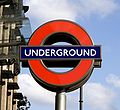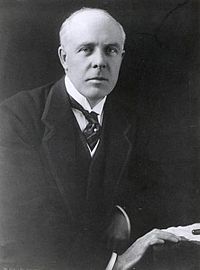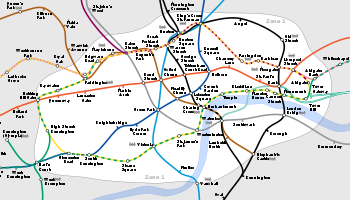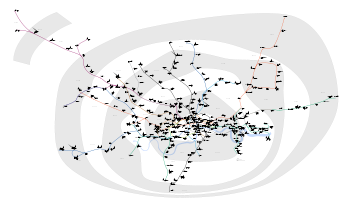- Portal:London Transport
-
THE LONDON TRANSPORT PORTAL
- Wikipedia portals:
- Culture
- Geography
- Health
- History
- Mathematics
- Natural sciences
- People
- Philosophy
- Religion
- Society
- Technology
London Transport
The London Transport system is one of the oldest and largest public transport systems in the world. Many components of its transport system, such as the double-decker bus, the Hackney Carriage black taxi and the London Underground, are internationally recognised symbols of London.
Most transport services in London are controlled by Transport for London (TfL), an executive agency of the Greater London Authority. TfL-controlled services include the London Underground, Docklands Light Railway, the London Overground, Buses and Trams, most of which accept payment by the Oyster card. TfL also administers the congestion charge zone and the low emission zone.
London has a comprehensive rail network with several major railway stations linking to the rest of the country. International travel is possible from two international railway stations at St Pancras International and Stratford International, which connect to mainland Europe through the Eurostar service, or from one of six international airports, including Heathrow or Gatwick.
London is the starting point for a number of motorway routes. The M25 is an orbital motorway which enables vehicles to avoid travelling through central London and is one of the busiest motorways in Europe.
More about Transport in London...






Buses Taxis Underground Overground DLR Tramlink National Rail River Services Heathrow Airport Selected article
The AEC Routemaster is a model of double-decker bus that was first built by Associated Equipment Company (AEC) in 1954 and was produced until 1968. Primarily front-engined, rear open platform buses, a small number of variants were produced with doors and/or front entrances. Introduced by London Transport in 1956, the Routemaster saw continuous service in London until 2005, and currently remains on two heritage routes in central London. In all, 2,876 Routemasters were built with all but a few delivered to London Transport. Approximately 1,000 are still in existence. A pioneering design, the Routemaster outlasted several of its replacement types in London. The unique features of the standard Routemaster were both praised and criticised. The open platform, while exposed to the elements, allowed boarding and alighting away from stops; and the presence of a conductor allowed minimal boarding time and optimal security, although the presence of conductors produced greater labour costs. The traditional red Routemaster has become one of the famous features of London, with much tourist paraphernalia continuing to bear Routemaster imagery, and with examples still in existence around the world.
More Selected articles
Selected biography
Albert Henry Stanley, 1st Baron Ashfield, PC, Kt, TD (8 August 1874 – 4 November 1948) was managing director, then chairman of the Underground Electric Railways Company of London and later chairman of the London Passenger Transport Board, during the London Underground's greatest period of expansion. Stanley was born in, Derbyshire, England. In 1880, his family emigrated to Detroit in the United States. In 1888, at the age of 14, Stanley left school and went to work as an office boy at the Detroit Street Railways Company. His abilities were recognised early and Stanley became General Superintendent of the company in 1894. In January 1907 he became general manager of the Underground Electric Railways Company of London (UERL) and after improving the company's fortunes, he became managing director in 1910. In 1914, he was knighted in recognition of his services to transport. After a period as President of the Board of Trade during World War I, Stanley became chairman of the UERL in 1919 and, in 1920, was made Baron Ashfield, of Southwell in the County of Nottingham.
Throughout the 1920s, Stanley and Herbert Morrison worked on plans for a unified transport organisation for London. The London Passenger Transport Board was created in 1933 with Stanley as chairman, a role he performed until 1947, overseeing major expansions of London's Underground network and integration of bus, tram and trolleybus services.
More Selected biographies
Selected picture
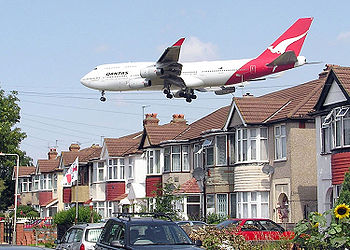
Qantas Boeing 747-400 about to land at Heathrow Airport, seen beyond the roofs of Myrtle Avenue, Hounslow.
Credit: ArpingstoneMore Selected pictures
In the news
- 16 November 2011 – Network Rail announces that the first 12-carriage trains will run on Thameslink services on 12 December.[1]
- 4 November 2011 – A Boeing 747-8F Superjumbo lands at Stansted Airport for the first time.[2]
- 1 November 2011 – Network Rail awards contracts worth £450 million to Costain and Balfour Beatty for the redevelopment of London Bridge station and modification of its tracks.[3]
- 28 October 2011 – Stansted Airport hosts Exercise Orange, a large scale CBRN training exercise involving police, fire and ambulance crews.[4]
- 17 October 2011 – Real time bus service information is now available via the internet for all of London's 19,500 bus stops.[5]
Archive
Did you know...
- ...that the Underground's architect Charles Holden and LPTB Managing Director Frank Pick were both sons of drapers?
- ...that sculptor Henry Moore's first public commission in 1928-29 was a relief sculpture West Wind for the Underground's headquarters at 55 Broadway?
- ...that the shortest distance between two stations is 250 metres (0.16 miles), between Leicester Square and Covent Garden on the Piccadilly line?
- ...that at Whitechapel the London Overground line runs below the London Underground line?
More Did you know...
Categories:- Transport portals
- United Kingdom portals
Wikimedia Foundation. 2010.

